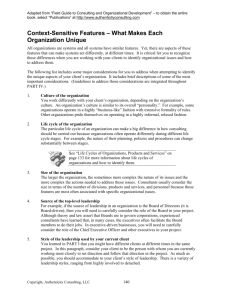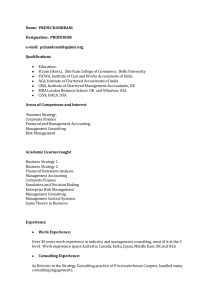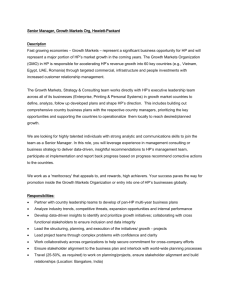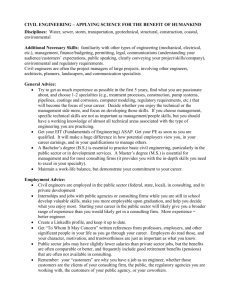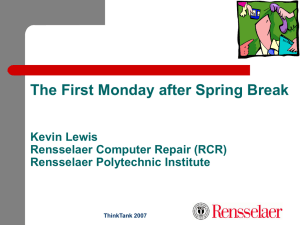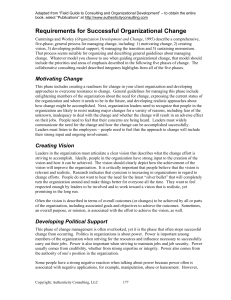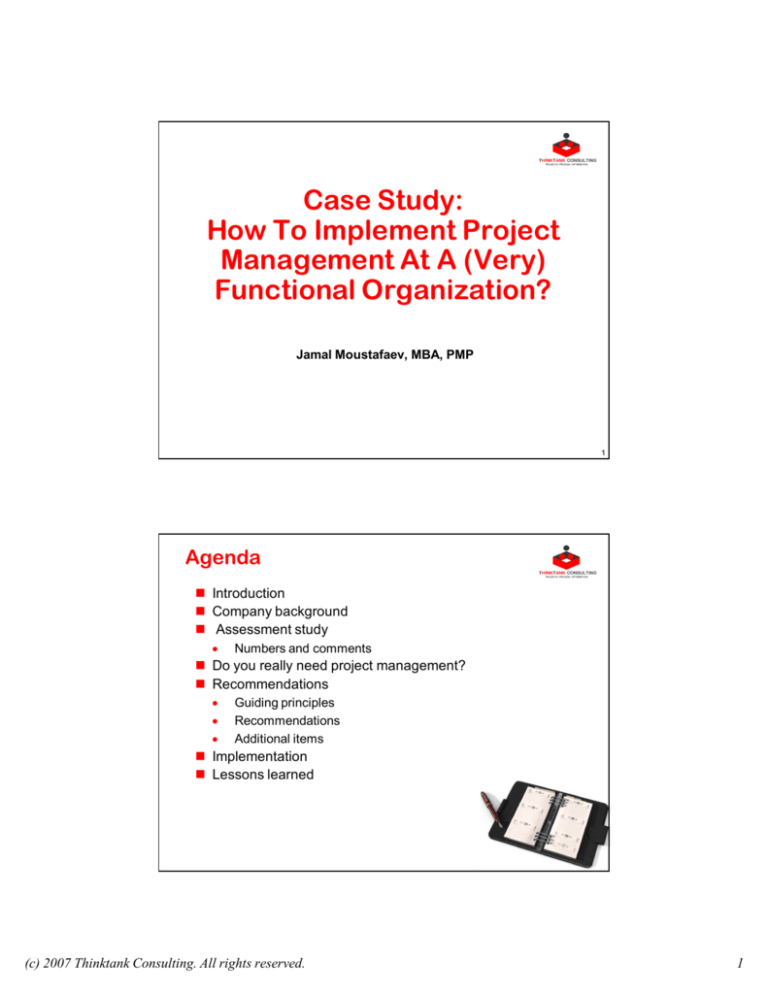
Case Study:
How To Implement Project
Management At A (Very)
Functional Organization?
Jamal Moustafaev, MBA, PMP
1
Agenda
Introduction
Company background
Assessment study
Numbers and comments
Do you really need project management?
Recommendations
Guiding principles
Recommendations
Additional items
Implementation
Lessons learned
2
(c) 2007 Thinktank Consulting. All rights reserved.
1
Introduction
I was contacted by a senior manager of a large
company who proceeded to tell me:
“Listen, we know that you have a project management
course and we are interested in it … But would you be
able to come in and just assess what is it that we are
doing wrong with projects and maybe customize your
course according to the findings?”
Obviously I agreed to get together with him
and we arranged for a meeting
3
Background
Organization involved in very large construction projects
with strong ties to federal, provincial and municipal
governments
Recently created through a merger several other
smaller firms
A significant growth in the number and size of their
projects (the largest ones hovering at around $1 billion)
Company started experiencing problems in
the areas of resource planning, resource
allocation and project management …
4
(c) 2007 Thinktank Consulting. All rights reserved.
2
Background
High-level problems:
Employees of the company were complaining that they
were too busy to fulfill all of their project and functional
duties
Senior management was concerned that a lot of projects
were late and the quality of final product was subpar
Issues with proper planning of the projects, adequate
project control and performance reporting
Many of the company’s flagship megaprojects were over
budget by almost 50%
Some of them were close to a year late
Senior Executive:
“There is something horribly wrong with our projects …
we are not entirely sure what it is and where to start since
there seems to be too many problems”
5
Functional Organization
Executives
Director,
Director,
Real Estate Engineering
Director,
IT
Director,
Legal
Director,
PR
PR Division
Engineering Division
Legal Division
Real Estate Division
Project C
Project D
IT Division
Project B
Finance Division
Project A
Director,
Finance
© 2008 Thinktank Consulting. All rights reserved
6
(c) 2007 Thinktank Consulting. All rights reserved.
3
Functional Organization
Executives
Director,
IT
Director,
Legal
Director,
PR
PR Division
Director,
Finance
Legal Division
Director,
Director,
Real Estate Engineering
Project X
IT Division
Finance Division
Engineering Division
Real Estate Division
Project Y
© 2008 Thinktank Consulting. All rights reserved
7
The Assessment Study
Methodology Used:
Better chance of people accepting our solutions if you can
map them directly to problems mentioned by the
employees
Interview a cross-section of organization’s employees
including C-level executives, department heads, project
specialists (company did not have any designated project
managers) and even some outsiders, including customers
and suppliers
In total: 13 department heads, 7 executives, 6 project
leads and 4 external people - both customers and
subcontractors - were interviewed
Key question:
“Whether you are a project
participant or a project victim,
what are the key problems you
have encountered on the company
projects?”
8
(c) 2007 Thinktank Consulting. All rights reserved.
4
The Assessment Study
Summary of Results
Percentage of
Interviewees
Lack of communications between the departments
98%
Lack of uniformity in project management approach
across the departments
Lack of accountability for cost & time overruns and
poor quality
Lack of feasibility analysis in project selection
92%
Projects are not prioritized properly
74%
Underestimation is an issue at our company
69%
Projects are frequently over the budget or late (either
underestimated or due to lack of skills)
66%
83%
79%
9
Memorable Quotes
Communications:
"One department makes a commitment, and another has
to fulfill it"
“Department A does its part on the project and then throws
it over the fence to the Department B”
"We do not recognize the interdependency of projects"
“I can’t speak for other teams, but it never happens in my
department”
10
(c) 2007 Thinktank Consulting. All rights reserved.
5
Memorable Quotes
Commonality of the Project Management Approach:
"Most of the templates are department-specific"
"I had to use templates from the previous company"
"There is a uniformity when have to get the money, but not
when running projects"
"Lack of understanding on what is the role of a project
manager"
11
Memorable Quotes
Project Accountability, Budgets and Timelines:
"Cost overruns are typically not viewed as too much of an
issue" (Accountability)
"If you don't have a plan, it is very difficult to be
accountable" (Accountability)
“How can you know whether you are on time or not if we
don’t document anything?” (Budgets and Timelines)
"We have historical data, but unrealistic timelines are still
imposed" (Estimation)
"We artificially decrease/hide costs in order
to get approval” (Estimation)
“I can’t speak for other teams, but
it never happens in my department”
12
(c) 2007 Thinktank Consulting. All rights reserved.
6
Memorable Quotes
Project Feasibility and Justification:
"There is resistance to the fair assessment of project
feasibility"
"Unlikely to get 100K to conduct a feasibility study of a 100
mil project"
"We are very quick to jump to solutions"
"Sometimes an executive pet project will inexplicably go
ahead“
“Sometimes the projects are initiated by a
simple ‘Wouldn’t it be cool if we could do this?”
13
Memorable Quotes
Personal Favourites:
“Our projects are so complicated, that no project manager
can understand all of the complexities!”
“Our administrative assistants are not very busy. We
should put them through your two-day project
management course and assign them to manage our
(multi-million dollar) projects. This alone will address all of
our problems!”
“I don’t understand why we are having
problems with our projects. After all we have
MS Project installed on almost every computer
in this office!”
“Yes, we do have issues with our projects,
but how do I know that project management
is the right answer?”
14
(c) 2007 Thinktank Consulting. All rights reserved.
7
HR Policies in the British Army
British army had a very strange management system in past
centuries
The ranks were not awarded for merit, valour or even
educational level achieved
They were available for sale from the War Office or from any
other officer who was willing to sell his rank
Officers who acquired their commissions were not paid a lot of
money; most of their income was generated from the spoils of
war
And yet people willingly paid enormous amounts of money for
these commissions.
There is a recorded sale of the colonel’s rank in 1840 for an
astounding sum of £30,000
© 2008 Thinktank Consulting. All rights reserved
15
HR Policies in the British Army
Let me tell you the story of one Arthur Wellesley.
In 1787 his family purchased him a commission of
a junior officer but he, then 18 years of age did not
feel like reporting to duty
The family managed to solve this problem by a
buying him a rank of colonel in charge of his own
regiment in 1794 (He was 25)
Initially Arthur suffered several losses at the hands of
Napoleon troops in the “low countries”, but in Spain and later
at Waterloo he managed to beat the French Emperor.
For his military feats Arthur Wellesley was granted the title of
the Duke of Wellington and peerage; in 1828 he was elected
to be the Prime Minister of England.
© 2008 Thinktank Consulting. All rights reserved
16
(c) 2007 Thinktank Consulting. All rights reserved.
8
Question
Why was this policy implemented and supported
by the British Army?
© 2008 Thinktank Consulting. All rights reserved
17
Question
This policy has never been implemented in
the British Navy. Why?
© 2008 Thinktank Consulting. All rights reserved
19
(c) 2007 Thinktank Consulting. All rights reserved.
9
Do We Need Project Management?
© 2008 Thinktank Consulting. All rights reserved
20
Recommendations
Guiding Principles:
Main focus - larger, strategic interdepartmental projects
•
Going after the “big fish”
Simplicity and user-friendliness of the processes
•
“Dropping” a full-scale PMBOK-type project
management framework would have probably
scared and turned-off most of the employees.
All proposals generated by Thinktank Consulting had to be
screened and analyzed by the “focus group” of company
employees with previous project management
experience.
•
This step was necessary to fine-tune
best practices project management
processes and documents to the
company realities
21
(c) 2007 Thinktank Consulting. All rights reserved.
10
PM Methodology & Templates
PROJECT
CHARTER
PROJECT
PLAN
CHANGE
REQUESTS
LESSONS
LEARNED
MEETING
MINUTES
STATUS
REPORTS
INITIATION
PLANNING
EXECUTION/CONTROL
CLOSING
© 2008 Thinktank Consulting. All rights reserved
22
PM Workshop
“Successful Hands-On Management of Modern-Day Projects”
course with:
Company-specific PM Methodology
Company-specific PM Documentation
Offer to 100 employees of the company
NOTE: we are not trying to create 100 project managers!
We are trying to introduce and spread the project management
culture
Attempt to achieve general familiarity
with the basic concepts of project
management
© 2008 Thinktank Consulting. All rights reserved
23
(c) 2007 Thinktank Consulting. All rights reserved.
11
Strategic PM
Introduce the role of a department-independent Project
Manager-Strategic Projects to the company
Should be independent of any “technical departments”:
Technical departments do not have the knowledge, resources
and time sufficient to train project managers and support the
development of the project management methodology
throughout the organization
If the project manager belongs to any of the technical
departments, the department head will be unlikely to release
him/her to run the entire interdepartmental project since internal
departmental tasks will be taking precedence over project
activities
The technical expertise of the member of the technical
department is better used on technical rather than project
management tasks
© 2008 Thinktank Consulting. All rights reserved
24
Pilot Project
Start with one large interdepartmental project (preferably
starting in early 2009) and assign an experienced project
manager to run this endeavor.
There are several advantages to this model:
It allows for a gradual learning about the role of project
management in the organization
It allows to demonstrate the positive effect of project
management by comparing the “before” and “after” metrics
It allows for people who are doubting the value of project
management to be introduced to it gradually
© 2008 Thinktank Consulting. All rights reserved
25
(c) 2007 Thinktank Consulting. All rights reserved.
12
Tying To The Problems
Project Management Methodology and Templates
Lack of communications
Lack of project management methodology
Lack of accountability
Lack of project feasibility/justification analysis
Project Management Workshop
Lack of communications
Lack of proper estimation
Lack of project management methodology
Lack of project feasibility/justification
© 2008 Thinktank Consulting. All rights reserved
26
Tying To The Problems
Project Manager – Strategic Projects
Lack of interdepartmental communications
Lack of uniformity in project management approach
Lack of accountability
Lack of project feasibility/justification analysis
Problem of underestimation
Projects are frequently over the budget or late
Project Feasibility, Project Selection and
Prioritization
To be handled in the Portfolio Management stage
© 2008 Thinktank Consulting. All rights reserved
27
(c) 2007 Thinktank Consulting. All rights reserved.
13
Additional Items
Metrics
Company-Wide Communications
Need to gather “before” and “after” metrics to assess progress
Need to come up with a way to communicate progress to the
entire company
Develop a Definition of a Strategic Project
> $1 million?
> $5 million?
> $50 million?
© 2008 Thinktank Consulting. All rights reserved
28
Implementation
1.
2.
3.
4.
5.
Project management methodology and documentation
proposed was validated by the focus group and approved by
the senior management.
All stakeholders have undergone a two-day project
management seminar
Four pilot strategic projects were selected
Project managers hired
Project management department with the
assistance of the IT department has created
a “Project Management” section on company
Intranet
© 2008 Thinktank Consulting. All rights reserved
29
(c) 2007 Thinktank Consulting. All rights reserved.
14
Conclusion – Lessons Learned
Never try to impose “off-the-shelf” project management
methodology onto a functional (traditional) organization:
Debrief key stakeholders at the every
milestone.
Interview a cross-section of company employees and, if possible
customers and suppliers to obtain the real project-related issues.
Use “best practices” project management methodology to tailor
the solutions proposed to the concerns voices by the people
working for the organization
Presentation software like PowerPoint with
charts, graphs and tables is your best friend!
Introduce the role of a full-time project
manager to the company.
Depending on the number of pilot projects
the organization will probably require more
than one.
© 2008 Thinktank Consulting. All rights reserved
30
Conclusion – Lessons Learned
Initially try to concentrate on the simplest forms of the
methodology.
Always use “focus groups”
If processes and documents become too complicated people will
find creative ways to ignore them!
This will ensure that they are properly fine-tuned to company
realities.
Try to determine what constitutes a project
and what doesn’t for that particular
organization.
Establish a threshold to distinguish between
“project” and “business as usual”.
© 2008 Thinktank Consulting. All rights reserved
31
(c) 2007 Thinktank Consulting. All rights reserved.
15
Conclusion – Lessons Learned
Run several one- or two-day company-wide project
management seminars.
Your mission is not to create several dozen project managers
“overnight” but rather to familiarize all of the potential project
stakeholders with the key concepts of project management.
If a significant resistance to change is encountered (very likely
scenario) try to apply a phased approach.
For example, select a group of pilot projects
to be run under the new methodology to be
followed by all flagship projects, to be
followed by all projects
© 2008 Thinktank Consulting. All rights reserved
32
Conclusion – Lessons Learned
Capturing the “before” and “after” project related data is
essential.
Otherwise it would be very difficult to prove to the naysayers
(and the executives) that the project performance and results
have indeed improved.
And finally, keep in mind that communications is the key
Intranet webpage dedicated to the new
methodology and project-related news,
seminars, debriefing lunch-and-learns,
short updates during functional department
head meetings – any combination of the
above-mentioned tools should be used to
carry the positive message to your
organization.
© 2008 Thinktank Consulting. All rights reserved
33
(c) 2007 Thinktank Consulting. All rights reserved.
16
The Book
If you liked this presentation, you may
like my book scheduled to come out in
April/May 2010
Table of Contents (partial):
What Is Project Management And Do You
Really Need It?
Things You Probably Didn't Know About
Estimation
Are We Supposed To Negotiate On
Projects?
How And Why Do We Write Project
Charters?
Kick-Starting Your Projects – The Scope
Definition Perspective
Who Needs Creativity In Projects And How
To Cultivate It?
How To Select The Best Projects?
How To Implement It All?
To be released by J.Ross Publishing
34
Questions
?
35
(c) 2007 Thinktank Consulting. All rights reserved.
17


